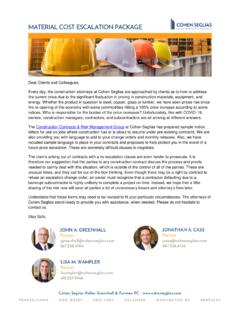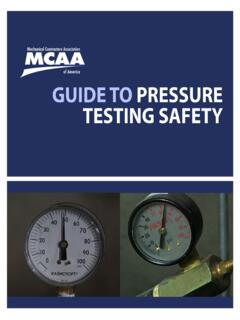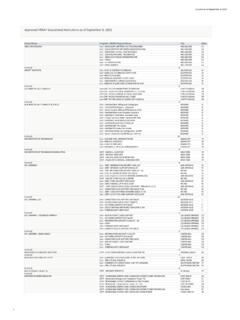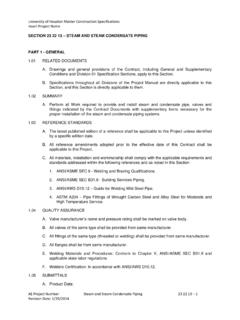Transcription of General Welding Guidelines - MCAA
1 General WeldingGuidelinesNational Certified pipe Welding BureauGeneral Welding Guidelines National Certified pipe Welding Bureau Revision date: April 2, 2013 2013 National Certified pipe Welding Bureau 1385 Piccard Drive Rockville, MD 20850 301-869-5800 Fax: 301-990-9690 The National Certified pipe Welding Bureau (NCPWB) gratefully acknowledges the permission from ASTM to use their data on copper tube sizes in this publication. CONTENTS MANDATORY PRACTICES General .. 3 Joints .. 3 Filler Metal .. 3 Postweld Heat Treatment .. 4 RECOMMENDED PRACTICES General .. 5 Joints .. 5 Electrodes and Filler Metals .. 8 Preheating and Interpass Temperature .. 9 Shielding and Backing Gas .. 10 Cleaning .. 13 Environmental Requirements .. 14 Welding Technique .. 14 Welding From Two Sides .. 15 Visual Examination .. 16 Repairs .. 18 Stamping of Welds .. 19 Safety .. 19 Welding Hazards .. 20 Welding Lens Shades.
2 21 ASME-P-Numbers .. 24 TABLES Table 1, Low-Hydrogen Electrode Exposure Limits .. 8 Table 2, Recommended Supplemental Preheat .. 10 Table 3, Piping .. 17 Table 4, Piping .. 17 Table 5, Welding Lens Shade Selections .. 21 Table 6, Determining Purge Time .. 22 FORWARD These General Welding Guidelines are intended to provide background information and supplementary instructions to contractors and their welders who are using National Certified pipe Welding Bureau Welding Procedures Specifications (WPSs). This document is divided into two sections: Mandatory Practices and Recommended Practices. The Mandatory Practices are in addition to the instructions provided on the WPS and are considered part of the requirements stated on the WPS. The Recommended Practices provides additional information to the welder on variables, which are not covered in the WPS. These practices are recommended to be followed unless other direction is provided by the welder s MANDATORY PRACTICES General All ASME Section IX variables are covered in the Welding Procedure Specifications (WPSs).
3 The welder shall follow the instructions in the WPS when making Code welds. In addition to the instructions in the WPSs, the following portion of the General Welding Guidelines shall be followed during all Welding . Joints Unless specifically required by the WPS or by details on the engineering drawings, the use of nonmetallic backing and nonfusing metal retainers is not permitted. When backing is shown as Required on the WPS, the backing shall be backing ring or strip, or it shall be weld metal deposited by another process or electrode type or the joint shall be made from both sides of the joint ( , backwelded). Fillet welds are considered Welding on backing, and all sizes of fillet welds may be made using any NCPWB WPS on any thickness or diameter base metal. Filler Metal Welding without the addition of filler metal, such as might be used for tight-butt welds on schedule 10 pipe or for wash passes made on the cover to improve surface appearance, is not permitted unless the WPS specifically permits Welding without the use of filler metal ( the column ROOT on the WPS has NONE for the filler metal.)
4 4 Postweld Heat Treatment The required postweld heat treatment temperature range indicated on the engineering drawing shall govern when using a Welding Procedure Specification, which permits the weld to be made either with or without heat treatment. Postweld heat treatment holding time and heating and cooling rates shall be in accordance with the applicable code or contract requirements. 5 RECOMMENDED PRACTICES General The instructions contained in this portion of the Guidelines provide additional information to the welder concerning variables, which are not usually addressed by the Welding Procedures. The direction provided by the Welding Procedure Specification and the Mandatory Practices in this document constitute the minimum requirements for code Welding . The above requirements may not be changed by the following Recommended Practices provided in this document. Joints End preparations shall be in accordance with the details provided in the construction drawing(s), or as provided on the WPS.
5 All groove welds shall be prepared and fit up in such a way that a full penetration weld can be made except where partial penetration Welding is shown on the construction or engineering drawing. This includes both butt and branch connection welds on piping. Care shall be taken when cutting the pipe to make the plane of the cut square to the axis of the pipe , so that the flat land and root spacing will be uniform all the way around the pipe . End preparations shall be made by mechanical cutting or flame cutting. Irregularities should be removed by grinding. The bevel shall be uniform so that the resulting land is uniform around the pipe . The finished surface shall be reasonably smooth and suitable for Welding . 6 The surfaces to be welded and the inside and outside surfaces of the base metal shall be cleared of all contamination for one inch back from the bevel before the pipe is aligned and tack welded. Special cleaning methods shall be used when specified in the Welding Procedure Specification.
6 Remove grease, oil and cutting fluid using appropriate solvents. After removing grease, oil or cutting fluid residue, remove paint, varnish, rust, dirt or oxide using a wire brush or grinding wheel. Paint which is designed to be welded over, such as Deoxaluminite may be welded over without removal. Brushing with a power wire brush to remove excess build-up ( , runs) of weldable coatings is recommended. When wire brushing stainless steel, use only austenitic stainless steel wire brushes. Brushes for use on stainless steel or other corrosion-resistant metals should be segregated and not be used on carbon or low alloy steel. These ordinary steel will contaminate the brush and result in surface rusting of the corrosion-resistant metal if the brush is used on corrosion-resistant metals. The components being joined shall be aligned to provide the root gap spacing given in the WPS. The inside surfaces shall be aligned to within 1/16", or as shown in the WPS. When the inside surfaces do not match within the required tolerance, the surfaces shall be ground or weld metal shall be added to bring the surfaces into alignment.
7 When the surfaces are ground or weld metal is added, the taper from the original surface shall not exceed 30 maximum on internal original surfaces and 3:1 (about 18 ) maximum on external surfaces. The minimum wall thickness required by engineering calculations shall be present after proper 7 alignment has been achieved. This may require the addition of weld metal to outside pipe wall. It is recommended that alignment be verified by using Hi-Lo gauges after has been fit-up and tack welded. When backing is shown as Required on the WPS, the backing shall be backing ring or strip or other material shown above, or it shall be weld metal deposited by another process or electrode type for welds made from one side. Welds which are made from both sides of a joint and fillet welds are considered as Welding on backing, in which case the same process and electrode may be used on both sides. Alignment shall be done using external alignment clamps or by tack Welding the ends.
8 The use of welded lugs or attachments and wedges to bring pipe into alignment is permitted. If the base metal is alloy steel, the preheat required by the WPS shall be used for tack Welding and for attachment of alignment materials. Lugs should be removed by cutting and grinding followed by visually inspecting the pipe surface for defects. Care should be taken not to grind into the base metal when removing temporary welds Tack welds, which will be incorporated into the final weld, shall be tapered on both ends to facilitate proper fusion. Any defective tack welds shall be removed by grinding. Tack welds, which have been removed, shall be replaced if necessary to maintain alignment or to prevent closing of the root opening during root pass Welding . Fillet weld sizes, as shown on the Welding Procedure Specification shall be used unless otherwise detailed on the engineering drawing. Fillet welds shall be made so that they penetrate fully into the root. 8 Electrodes and Filler Metals Low hydrogen Welding electrodes, such as E7015, E7018, E8018, E9018 and E308-16 shall be purchased in vacuum-sealed plastic wrappers or hermetically sealed containers.
9 After removal from the containers, these electrodes shall be stored in holding ovens at 200 to 300 F. Welders shall not take more electrodes than can be consumed in the time permitted as shown in Table 1 when using leather rod pouches or other unheated containers. These electrodes are not permitted to be stored in pockets of clothing, since they will absorb body moisture. The use of portable holding ovens is recommended. Electrodes that have been exposed to the atmosphere for more time than permitted by Table 1 shall be destroyed or baked at 700 50 F for 2-hour minimum. TABLE 1 Low-Hydrogen Electrode Exposure Time Limits Electrode Class Exposure Time* E7018 8 hours E8018 4 hours E9018, E502 2 hours E10018, E11018 2 hours E308-16 8 hours * For electrodes designated as moisture resistant ( , E7018R), the exposure times may be doubled. Note: In the above examples, the electrode classes E7018, E8018, etc. are intended to include all other low-hydrogen classes of electrodes, such as E7015, E7016, E8015, E9016, etc.
10 The electrode class E308-16 is intended to include all 9 E3XX-15 and E3XX-16 electrodes. The electrode E502 is intended to include all E4XX, E5XX and E7Cr electrodes. When portable heated rod containers are used, there is no time limit provided the containers are kept hot. Electrodes other than the low-hydrogen type shall be stored in a dry place, sheltered from the elements, preferably at normal room temperature and humidity. E6010 and E6011 electrodes shall never, ever be stored in heated holding ovens. The use of low-hydrogen Welding electrodes is recommended for all Shielded Metal Arc Welding (SMAW), except that the use of EXX10 or EXX11 classification is recommended for root passes in order to assure full penetration. Preheating and Interpass Temperature Preheating and interpass temperature shall be as indicated in the Welding Procedure Specification. When higher preheat is required by the applicable construction code ( , , etc.), that preheat shall be used for production Welding .












